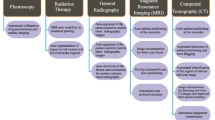Abstract
Deep learning has caused a third boom of artificial intelligence and great changes of diagnostic medical imaging systems such as radiology, pathology, retinal imaging, dermatology inspection, and endoscopic diagnosis will be expected in the near future. However, various attempts and new methods of deep learning have been proposed in recent years, and their progress is extremely fast. Therefore, at the initial stage when medical artificial intelligence papers were published, the artificial intelligence technology itself may be old technology or well-known general-purpose common technology. Therefore, the author has reviewed state-of-the-art computer vision papers and presentations of 2018 using deep learning technologies, which will have future clinical potentials selected from the point of view of a radiologist such as generative adversarial network, knowledge distillation, and general image data sets for supervised learning.



Similar content being viewed by others
References
Top Conferences for Image Processing & Computer Vision. http://www.guide2research.com/topconf/computer-vision. Accessed 9 Nov 2018.
CVPR2018 http://cvpr2018.thecvf.com/. Accessed 9 Nov 2018.
Jordi Pont-Tuset’s site—CVPR 2018: are GANs the new deep? http://jponttuset.cat/are-gans-the-new-deep/. Accessed 9 Nov 2018.
National Highway Traffic Safety Administration, Preliminary Statement of Policy, Concerning Automated Vehicles https://www.nhtsa.gov/staticfiles/rulemaking/pdf/Automated_Vehicles_Policy.pdf. Accessed 9 Nov 2018.
Japanese Ministry of Health, Labor and Welfare, Promotion of AI in health care field report https://www.mhlw.go.jp/file/05-Shingikai-10601000-Daijinkanboukouseikagakuka-Kouseikagakuka/0000169230.pdf. Accessed 9 Nov 2018.
Mueller F, Bernard F, Sotnychenko O, Mehta D, Sridhar S, Casas D, Theobalt C. Ganerated hands for real-time 3d hand tracking from monocular RGB. In: O’Conner L (ed) Proceedings of the IEEE conference on computer vision and pattern recognition. Piscataway, NJ: IEEE Computer Society Conference Publishing Services; 2018. pp. 49–59.
Goodfellow IJ, Pouget-Abadie J, Mirza M, Xu B, Warde-Farley D, Ozair S, Bengio Y. Generative adversarial nets. Adv Neural Inf Process Syst. 2014;2014:2672–80.
Radford A, Metz L, Chintala S (2015) Unsupervised representation learning with deep convolutional generative adversarial networks. arXiv preprint arXiv:1511.06434.
Karras T, Aila T, Laine S, Lehtinen J (2017) Progressive growing of GANs for improved quality. Stability, and variation. arXiv preprint arXiv:710.10196.
Mirza M, Osindero S (2014) Conditional generative adversarial nets. arXiv preprint arXiv:1411.1784.
Isola P, Zhu JY, Zhou T, Efros AA (2017) Image-to-image translation with conditional adversarial networks. arXiv preprint arXiv:1611.07004.
Zhu JY, Park T, Isola P, Efros AA (2017) Unpaired image-to-image translation using cycle-consistent adversarial networks. arXiv preprint arXiv:1703.10593.
Choi Y, Choi M, Kim M, Ha JW, Kim S, Choo J (2017) Stargan: unified generative adversarial networks for multi-domain image-to-image translation. arXiv preprint, 1711.
Odena A, Olah C, Shlens J (2017) Conditional image synthesis with auxiliary classifier gans. arXiv preprint arXiv:1610.09585.
Zhang H, Goodfellow I, Metaxas D, Odena A (2018) Self-Attention Generative Adversarial Networks. arXiv preprint arXiv:1805.08318.
Huang X, Li Y, Poursaeed O, Hopcroft JE, Belongie SJ. Stacked generative adversarial networks. CVPR. 2017;2:3.
A Gentle Introduction to Transfer Learning for Deep Learning https://machinelearningmastery.com/transfer-learning-for-deep-learning/. Accessed 9 Nov 2018.
Ensemble learning—scholarpedia http://www.scholarpedia.org/article/Ensemble_learning. Accessed 9 Nov 2018.
Knowledge—Neural Network Distiller https://nervanasystems.github.io/distiller/knowledge_distillation/index.html. Accessed 9 Nov 2018.
Li N, Cohen WW, Koedinger KR, Matsuda N (2011) A machine learning approach for automatic student model discovery. In Edm 31–40. https://wwcohen.github.io/postscript/edm-2011.pdf. Accessed 9 Nov 2018.
Romero A, Ballas N, Kahou SE, Chassang A, Gatta C, Bengio Y (2014) Fitnets: hints for thin deep nets. arXiv preprint arXiv:1412.6550.
Furlanello T, Lipton ZC, Tschannen M, Itti L, Anandkumar A (2018) Born again neural networks. arXiv preprint arXiv:1805.04770.
Hinton G, Vinyals O, Dean J (2015) Distilling the knowledge in a neural network. arXiv preprint arXiv:1503.02531.
Gao J, Li Z, Nevatia R (2017) Knowledge concentration: learning 100 K object classifiers in a single CNN. arXiv preprint arXiv:1711.07607.
arXiv Times/datasets at master, arXivTimes/arXivTimes, GitHub https://github.com/arXivTimes/arXivTimes/tree/master/datasets. Accessed 9 Nov 2018.
LabelMe. The Open annotation tool http://labelme.csail.mit.edu/Release3.0/. Accessed 9 Nov 2018.
Russell BC, Torralba A, Murphy KP, Freeman WT. LabelMe: a database and web-based tool for image annotation. Int J Comput Vision. 2008;77(1–3):157–73.
VATIC—video annotation tool—UC Irvine http://www.cs.columbia.edu/~ vondrick/vatic/. Accessed 9 Nov 2018.
Vondrick C, Patterson D, Ramanan D. Efficiently scaling up crowdsourced video annotation. Int J Comput Vision. 2013;101(1):184–204.
ImageNet http://www.image-net.org/. Accessed 9 Nov 2018.
Deng J, Dong W, Socher R, Li LJ, Li K, Fei-Fei L. Imagenet: a large-scale hierarchical image database. In: Flynn P, Mortensen E (eds.) Proceedings / CVPR, IEEE computer society conference on computer vision and pattern recognition (CVPR 2009), 20–25 June 2009, Miami, Florida, USA, pp 248–55.
CoPhIR—COntent-based Photo Image Retrieval http://cophir.isti.cnr.it/. Accessed 9 Nov 2018.
Bolettieri P, Esuli A, Falchi F, Lucchese C, Perego R, Piccioli T, Rabitti F (2009) CoPhIR: a test collection for content-based image retrieval. arXiv preprint arXiv:0905.4627.
Tiny Images Dataset http://horatio.cs.nyu.edu/mit/tiny/data/. Accessed 9 Nov 2018.
SUN Database https://groups.csail.mit.edu/vision/SUN/. Accessed 9 Nov 2018.
MNIST handwritten digit database, Yann LeCun, Corinna Cortes and Chris Burges http://yann.lecun.com/exdb/mnist/. Accessed 9 Nov 2018.
MegaFace and MF2: Million-Scale Face Recognition http://megaface.cs.washington.edu/. Accessed 9 Nov 2018.
Author information
Authors and Affiliations
Corresponding author
Ethics declarations
Conflict of interest
The Conflict of Interest form and the Ethical Statement: no potential conflict of interest and of the commercial entities.
Additional information
Publisher's Note
Springer Nature remains neutral with regard to jurisdictional claims in published maps and institutional affiliations.
About this article
Cite this article
Nakata, N. Recent technical development of artificial intelligence for diagnostic medical imaging. Jpn J Radiol 37, 103–108 (2019). https://doi.org/10.1007/s11604-018-0804-6
Received:
Accepted:
Published:
Issue Date:
DOI: https://doi.org/10.1007/s11604-018-0804-6




